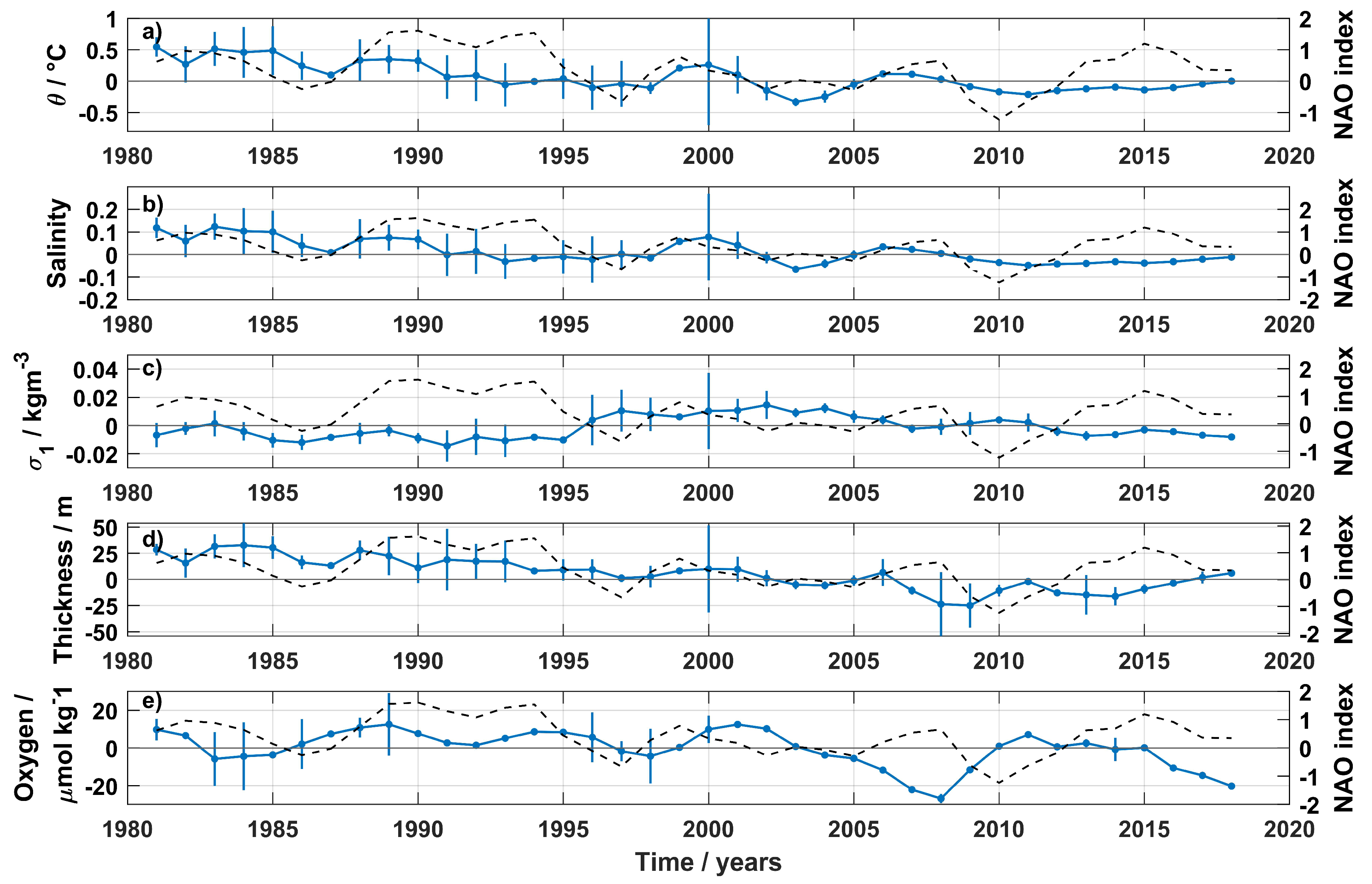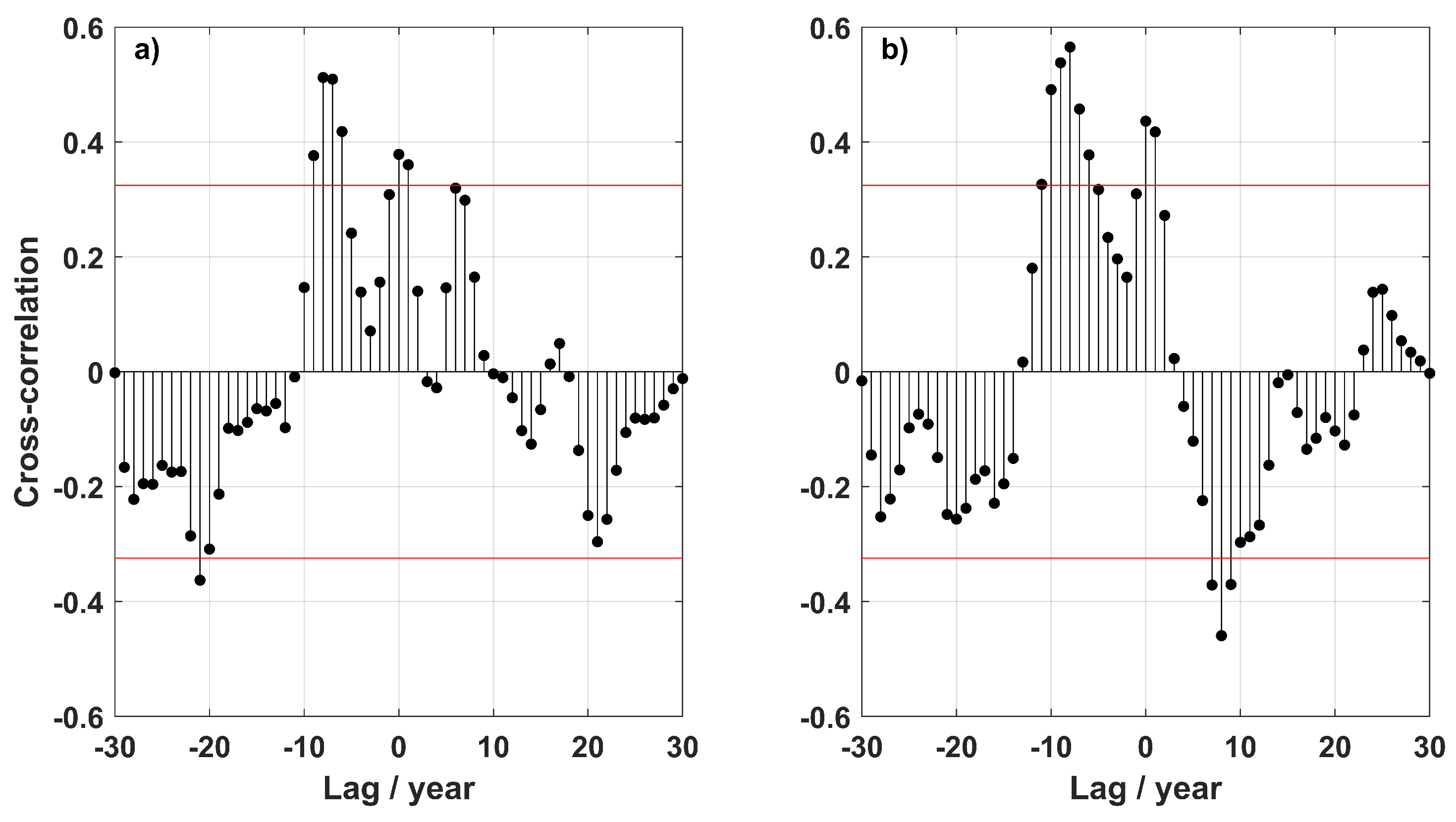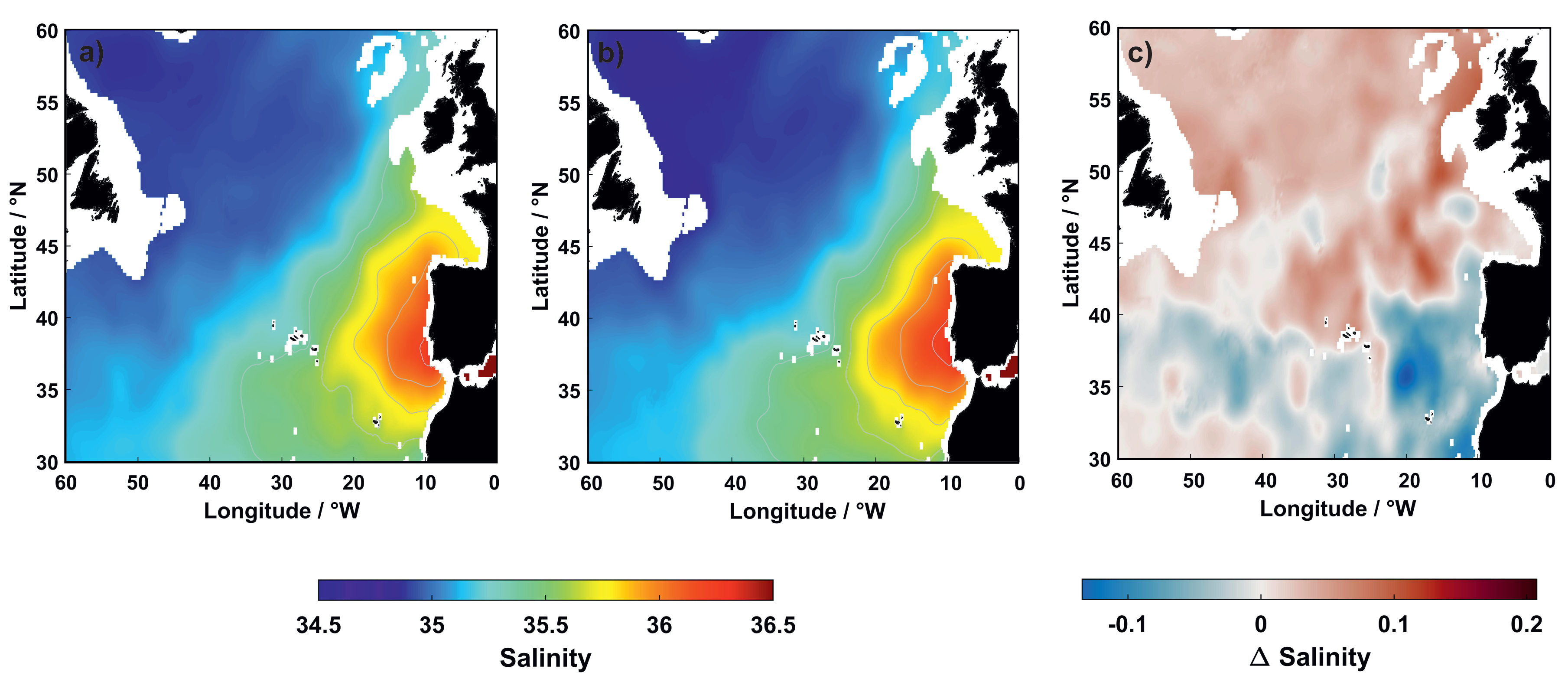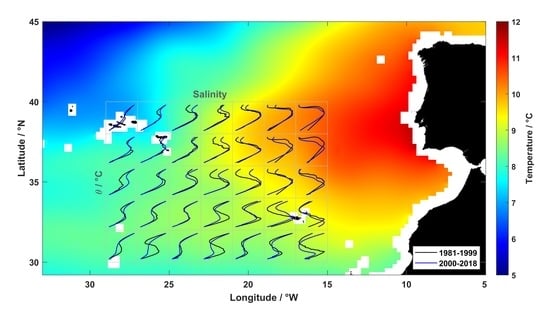Mediterranean Water Properties at the Eastern Limit of the North Atlantic Subtropical Gyre since 1981
Abstract
1. Introduction

2. Data and Methods
2.1. Temperature, Salinity and Oxygen Time-Series

2.2. North Atlantic Oscillation (NAO)
3. Results
3.1. Interannual Variability of MOW’s Properties Core
3.2. NAO Impact at MOW Core Properties
4. Discussion
5. Conclusions
Supplementary Materials
Author Contributions
Funding
Data Availability Statement
Acknowledgments
Conflicts of Interest
Abbreviations
| AAIW | Antarctic Intermediate Water |
| CTD | Conductivity, Temperature, Depth |
| LIW | Levantine Intermediate Water |
| LSW | Labrador Sea Water |
| MOW | Mediterranean Outflow Water |
| NAO | North Atlantic Oscillation |
| NEA | Northeast Atlantic |
| TDW | Tyrrhenian Deep Water |
| WMDW | Western Mediterranean Deep Water |
| WOA | World Ocean Atlas |
| WOD | World Ocean Database |
References
- Zenk, W. On the Mediterranean outflow west of Gibraltar. Meteor Forschungsergebnisse A 1975, 16, 35–43. [Google Scholar]
- Ambar, I.; Howe, M.R.; Abdullah, M.I. A Physical and Chemical Description of the Mediterranean Outflow in the Gulf of Cadiz. Dtsch. Hydrogr. Z. 1976, 29, 58–68. [Google Scholar] [CrossRef]
- Reid, J.L. On the contribution of the Mediterranean Sea outflow to the Norwegian-Greenland Sea. Deep-Sea Res. Part A Oceanogr. Res. Pap. 1979, 26, 1199–1223. [Google Scholar] [CrossRef]
- Bower, A.S.; Serra, N.; Ambar, I. Structure of the Mediterranean Undercurrent and Mediterranean Water spreading around the southwestern Iberian Peninsula. J. Geophys. Res. 2002, 107, 3161. [Google Scholar] [CrossRef]
- Reid, J.L. On the Middepth Circulation and Salinity Field in the North Atlantic Ocean. J. Geophys. Res. 1978, 83, 5063–5067. [Google Scholar] [CrossRef]
- Iorga, M.C.; Lozier, M.S. Signatures of the Mediterranean outflow from a North Atlantic climatology: 1. Salinity and density fields. J. Geophys. Res. 1999, 104, 25985–26009. [Google Scholar] [CrossRef]
- Serra, N.; Ambar, I.; Käse, R.H. Observations and numerical modelling of the Mediterranean outflow splitting and eddy generation. Deep-Sea Res. II 2005, 52, 383–408. [Google Scholar] [CrossRef]
- Armi, L.; Zenk, W. Large Lenses of Highly Saline Mediterranean Water. J. Phys. Oceanogr. 1984, 14, 1560–1576. [Google Scholar] [CrossRef]
- Richardson, P.L.; McCartney, M.S.; Maillard, C. A search for meddies in historical data. Dyn. Atmos. Ocean. 1991, 15, 241–265. [Google Scholar] [CrossRef]
- van Aken, H.M. The hydrography of the mid-latitude Northeast Atlantic Ocean II: The intermediate water masses. Deep-Sea Res. I 2000, 47, 789–824. [Google Scholar] [CrossRef]
- Siedler, G.; Armi, L.; Müller, T.J. Meddies and decadal changes at the Azores Front from 1980 to 2000. Deep-Sea Res. II 2005, 52, 583–604. [Google Scholar] [CrossRef]
- Carracedo, L.I.; Gilcoto, M.; Mercier, H.; Pérez, F.F. Seasonal dynamics in the Azores-Gibraltar Strait region: A climatologically-based study. Prog. Oceanogr. 2014, 122, 116–130. [Google Scholar] [CrossRef]
- Sánchez-Leal, R.F.; Bellanco, M.J.; Fernández-Salas, L.M.; García-Lafuente, J.; Gasser-Rubinat, M.; González-Pola, C.; Hernández-Molina, F.J.; Pelegrí, J.L.; Peliz, A.; Relvas, P.; et al. The Mediterranean Overflow in the Gulf of Cadiz: A rugged journey. Sci. Adv. 2017, 3, eaao0609. [Google Scholar] [CrossRef] [PubMed]
- Izquierdo, A.; Mikolajewicz, U. The role of tides in the spreading of Mediterranean Outflow waters along the southwestern Iberian margin. Ocean. Model. 2019, 133, 27–43. [Google Scholar] [CrossRef]
- de Pascual-Collar, Á.; Sotillo, M.G.; Levier, B.; Aznar, R.; Lorente, P.; Amo-Baladrón, A.; Álvarez-Fanjul, E. Regional circulation patterns of Mediterranean Outflow Water near the Iberian and African continental slopes. Ocean Sci. 2019, 15, 565–582. [Google Scholar] [CrossRef]
- Candela, J. Chapter 5.7 Mediterranean water and global circulation. In Ocean Circulation and Climate; Siedler, G., Church, J., Gould, J., Eds.; Academic Press: Cambridge, MA, USA, 2001; Volume 77, pp. 417–429. [Google Scholar] [CrossRef]
- Levitus, S.; Antonov, J.I.; Boyer, T.P.; Stephens, C. Warming of the World Ocean. Science 2000, 287, 2225–2229. [Google Scholar] [CrossRef]
- Arbic, B.K.; Owens, W.B. Climatic Warming of Atlantic Intermediate Waters. J. Clim. 2001, 14, 4091–4108. [Google Scholar] [CrossRef]
- Potter, R.A.; Lozier, M.S. On the warming and salinification of the Mediterranean outflow waters in the North Atlantic. Geophys. Res. Lett. 2004, 31, L01202. [Google Scholar] [CrossRef]
- Leadbetter, S.J.; Williams, R.G.; McDonagh, E.L.; King, B.A. A twenty year reversal in water mass trends in the subtropical North Atlantic. Geophys. Res. Lett. 2007, 34, L12608. [Google Scholar] [CrossRef]
- Soto-Navarro, J.; Criado-Aldeanueva, F.; Sánchez-Garrido, J.C.; García-Lafuente, J. Recent thermohaline trends of the Atlantic waters inflowing to the Mediterranean Sea. Geophys. Res. Lett. 2012, 39, L01604. [Google Scholar] [CrossRef]
- González-Pola, C.; Lavín, A.; Vargas-Yáñez, M. Intense warming and salinity modification of intermediate water masses in the southeastern corner of the Bay of Biscay for the period 1992–2003. J. Geophys. Res. 2005, 110, C05020. [Google Scholar] [CrossRef]
- Costoya, X.; deCastro, M.; Gómez-Gesteira, M. Thermocline trends in the Bay of Biscay from Argo floats over the decade 2004–2013. J. Mar. Syst. 2014, 139, 159–165. [Google Scholar] [CrossRef]
- Millot, C.; Candela, J.; Fuda, J.L.; Tber, Y. Large warming and salinification of the Mediterannean outflow due to changes in its composition. Deep-Sea Res. I 2006, 53, 656–666. [Google Scholar] [CrossRef]
- Lozier, M.S.; Sindlinger, L. On the Source of Mediterranean Overflow Water Property Changes. J. Phys. Oceanogr. 2009, 39, 1800–1817. [Google Scholar] [CrossRef][Green Version]
- Bozec, A.; Lozier, M.S.; Chassignet, E.P.; Halliwell, G.R. On the variability of the Mediterranean Outflow Water in the North Atlantic from 1948 to 2006. J. Geophys. Res. 2011, 116, C09033. [Google Scholar] [CrossRef]
- Chaudhuri, A.H.; Gangopadhyay, A.; Bisagni, J.J. Contrasting Response of the Eastern and Western North Atlantic Circulation to an Episodic Climate Event. J. Phys. Oceanogr. 2011, 41, 1630–1638. [Google Scholar] [CrossRef]
- Krahmann, G.; Schott, F. Longterm increases in Western Mediterranean salinities and temperatures: Anthropogenic and climatic sources. Geophys. Res. Lett. 1998, 25, 4209–4212. [Google Scholar] [CrossRef]
- Naranjo, C.; García-Lafuente, J.; Sammartino, S.; Sánchez-Garrido, J.C.; Sánchez-Leal, R.; Jesús Bellanco, M. Recent changes (2004–2016) of temperature and salinity in the Mediterranean outflow. Geophys. Res. Lett. 2017, 44, 5665–5672. [Google Scholar] [CrossRef]
- Dickson, R.; Lazier, J.; Meincke, J.; Rhines, P.; Swift, J. Long-term coordinated changes in the convective activity of the North Atlantic. Prog. Oceanogr. 1996, 38, 241–295. [Google Scholar] [CrossRef]
- Lozier, M.S.; Steward, N.M. On the Temporally Varying Northward Penetration of Mediterranean Overflow Water and Eastward Penetration of Labrador Sea Water. J. Phys. Oceanogr. 2008, 38, 2097–2103. [Google Scholar] [CrossRef]
- Good, S.A.; Martin, M.J.; Rayner, N.A. EN4: Quality controlled ocean temperature and salinity profiles and monthly objective analyses with uncertainty estimates. J. Geophys. Res. Ocean. 2013, 118, 6704–6716. [Google Scholar] [CrossRef]
- Zweng, M.M.; Reagan, J.R.; Seidov, D.; Boyer, T.P.; Locarnini, R.A.; Garcia, H.E.; Mishonov, A.V.; Baranova, O.K.; Weathers, K.; Paver, C.R.; et al. World Ocean Atlas 2018, Volume 2: Salinity; NOAA Atlas NESDIS 82; NOAA: Washington, DC, USA, 2018; p. 50.
- Daniault, N.; Mercier, H.; Lherminier, P.; Sarafanov, A.; Falina, A.; Zunino, P.; Pérez, F.F.; Ríos, A.F.; Ferron, B.; Huck, T.; et al. The northern North Atlantic Ocean mean circulation in the early 21st century. Prog. Oceanogr. 2016, 146, 142–158. [Google Scholar] [CrossRef]
- Wong, A.; Wijffels, S.E.; Riser, S.C.; Pouliquen, S.; Hosoda, S.; Roemmich, D.; Gilson, J.; Johnson, G.C.; Martini, K.; Murphy, D.J.; et al. Argo Data 1999–2019: Two Million Temperature-Salinity Profiles and Subsurface Velocity Observations From a Global Array of Profiling Floats. Front. Mar. Sci. 2020, 7, 700. [Google Scholar] [CrossRef]
- Wong, A.; Keeley, R.; Carval, T.; Argo Data Management Team. Argo Quality Control Manual for CTD and Trajectory Data; Ifremer: Brest, France, January 2020. [Google Scholar] [CrossRef]
- Argo. Argo float data and metadata from Global Data Assembly Centre (Argo GDAC). SEANOE 2000. [Google Scholar] [CrossRef]
- Garcia, H.E.; Weather, K.; Paver, C.R.; Smolyar, I.; Boyer, T.P.; Locarnini, R.A.; Zweng, M.M.; Mishonov, A.V.; Baranova, O.K.; Seidov, D.; et al. World Ocean Atlas 2018, Volume 3: Dissolved Oxygen, Apparent Oxygen Utilization, and Oxygen Saturation; Mishonov Technical, Ed.; NOAA Atlas NESDIS 83; NOAA: Washington, DC, USA, 2018; p. 38.
- UNESCO. Algorithms for Computation of Fundamental Properties of Seawater. UNESCO Tech. Pap. Mar. Sci. 1983, 44, 1–53. [Google Scholar]
- Barnes, S.L. Mesoscale Objective Map Analysis Using Weighted Time-Series Observations; NOAA Technical Memorandum ERL NSSL 62; NOAA: Washington, DC, USA, 1973.
- Pierce, S. Stephen Pierce (2020). Barnes Objective Analysis. 2010. Available online: https://www.mathworks.com/matlabcentral/fileexchange/28666-barnes-objective-analysis (accessed on 15 November 2020).
- Frazão, H.C.; Prien, R.D.; Müller, T.J.; Schulz-Bull, D.E.; Waniek, J.J. 30 years of temporal variability of temperature and currents below the main thermocline between 1980–2009 in the subtropical Northeast Atlantic (Kiel 276, 33° N, 22° W). J. Mar. Syst. 2021, 217, 103517. [Google Scholar] [CrossRef]
- Müller, T.J.; Waniek, J.J. KIEL276 Time Series Data from Moored Current Meters 33°N, 22°W, 5285 m Water Depth. March 1980–April 2011. Background Information and Data Compilation; GEOMAR Report Nr. 13; GEOMAR: Kiel, Germany, 2013. [Google Scholar]
- Bashmachnikov, I.; Nascimento, A.; Neves, F.; Menezes, T.; Koldunov, N.V. Distribution of intermediate water masses in the subtropical northeast Atlantic. Ocean. Sci. 2015, 11, 803–827. [Google Scholar] [CrossRef]
- Thomson, R.E.; Emery, W.J. Chapter 3—Statistical Methods and Error Handling. In Data Analysis Methods in Physical Oceanography, 3rd ed.; Thomson, R.E., Emery, W.J., Eds.; Elsevier: Amsterdam, The Netherlands, 2014; pp. 219–311. [Google Scholar] [CrossRef]
- Hurrell, J. The Climate Data Guide: Hurrell North Atlantic Oscillation (NAO) Index (Station-Based). 2020. Available online: https://climatedataguide.ucar.edu/climate-data/hurrell-north-atlantic-oscillation-nao-index-station-based (accessed on 4 March 2020).
- Hurrell, J.; Kushnir, Y.; Ottersen, G.; Visbeck, M. An overview of the North Atlantic oscillation. Geophys.-Monogr.-Am. Geophys. Union 2003, 134, 1–36. [Google Scholar]
- Hurrell, J.W.; Trenberth, K.E. Global Sea Surface Temperature Analyses: Multiple Problems and Their Implications for Climate Analysis, Modeling, and Reanalysis. Bull. Am. Meteorol. Soc. 1999, 80, 2661–2678. [Google Scholar] [CrossRef]
- Gregory, J.M.; Banks, H.T.; Stott, P.A.; Lowe, J.A.; Palmer, M.D. Simulated and observed decadal variability in ocean heat content. Geophys. Res. Lett. 2004, 31, L15312. [Google Scholar] [CrossRef]
- Käse, R.; Zenk, W. Structure of the Mediterranean Water and meddy characteristics in the northeastern Atlantic. In The Warmwatersphere of the North Atlantic Ocean; Krauss, W., Ed.; Gebrüder Borntraeger: Berlin, Germany, 1996; pp. 365–395. [Google Scholar]
- Somavilla, R.; González-Pola, C.; Rodriguez, C.; Josey, S.A.; Sánchez, R.F.; Lavín, A. Large changes in the hydrographic structure of the Bay of Biscay after the extreme mixing of winter 2005. J. Geophys. Res. 2009, 114, C01001. [Google Scholar] [CrossRef]
- Curry, R.G.; McCartney, M.S.; Joyce, T.M. Oceanic transport of subpolar climate signals to mid-depth subtropical waters. Nature 1998, 391, 575–577. [Google Scholar] [CrossRef]
- Mavropoulou, A.M.; Vervatis, V.; Sofianos, S. Dissolved oxygen variability in the Mediterranean Sea. J. Mar. Syst. 2020, 208, 103348. [Google Scholar] [CrossRef]
- Schroeder, K.; Chiggiato, J.; Bryden, H.L.; Borghini, M.; Ismail, S.B. Abrupt climate shift in the Western Mediterranean Sea. Sci. Rep. 2016, 6, 23009. [Google Scholar] [CrossRef]
- Johnson, G.C.; Gruber, N. Decadal water mass variations along 20° W in the Northeastern Atlantic Ocean. Prog. Oceanogr. 2007, 73, 277–295. [Google Scholar] [CrossRef]
- Stendardo, I.; Gruber, N. Oxygen trends over five decades in the North Atlantic. J. Geophys. Res. 2012, 117, C11004. [Google Scholar] [CrossRef]
- Stendardo, I.; Kieke, D.; Rhein, M.; Gruber, N.; Steinfeldt, R. Interannual to decadal oxygen variability in the mid-depth water masses of the eastern North Atlantic. Deep-Sea Res. I 2015, 95, 85–98. [Google Scholar] [CrossRef]
- Helm, K.P.; Bindoff, N.L.; Church, J.A. Observed decreases in oxygen content of the global ocean. Geophys. Res. Lett. 2011, 38, L23602. [Google Scholar] [CrossRef]
- Schmidtko, S.; Stramma, L.; Visbeck, M. Decline in global oceanic oxygen content during the past five decades. Nature 2017, 542, 335–339. [Google Scholar] [CrossRef]
- Eden, C.; Willebrand, J. Mechanism of Interannual to Decadal Variability of the North Atlantic Circulation. J. Clim. 2001, 14, 2266–2280. [Google Scholar] [CrossRef]
- Katz, E.J. The Levantine Intermediate Water between the Strait of Sicily and the Strait of Gibraltar. Deep-Sea Res. 1972, 19, 507–520. [Google Scholar] [CrossRef]
- Stommel, H. Deep winter-time convection in the Western Mediterranean Sea. In Studies in Physical Oceanography; Gordon, A.L., Ed.; Gordon and Breach: New York, NY, USA, 1972; Volume 2, pp. 207–218. [Google Scholar]
- Fiúza, A.F.G.; Hamann, M.; Ambar, I.; Díaz del Río, G.; González, N.; Cabanas, J.M. Water masses and their circulation off western Iberian during May 1993. Deep-Sea Res. I 1998, 45, 1127–1160. [Google Scholar] [CrossRef]
- Sarafanov, A.; Falina, A.; Sokov, A.; Demidov, A. Intense warming and salinification of intermediate waters of southern origin in the eastern subpolar North Atlantic in the 1990s to mid-2000s. J. Geophys. Res. 2008, 113, C12022. [Google Scholar] [CrossRef]
- Hurrell, J. Decadal trends in the North Atlantic Oscillation: Regional temperatures and precipitation. Science 1995, 269, 676–679. [Google Scholar] [CrossRef] [PubMed]
- Cunningham, S.A.; Alderson, S. Transatlantic temperature and salinity changes at 24.5° N from 1957 to 2004. Geophys. Res. Lett. 2007, 34, L14606. [Google Scholar] [CrossRef]
- Fusco, G.; Artale, V.; Cotroneo, Y.; Sannino, G. Thermohaline variability of Mediterranean Water in the Gulf of Cadiz, 1948–1999. Deep-Sea Res. I 2008, 55, 1624–1638. [Google Scholar] [CrossRef]
- García-Lafuente, J.; Delgado, J.; Sánchez Román, A.; Soto, J.; Carracedo, L.; Díaz del Río, G. Interannual variability of the Mediterranean outflow observed in Espartel sill, western Strait of Gibraltar. J. Geophys. Res. Ocean. 2009, 114, C10018. [Google Scholar] [CrossRef]
- Naranjo, C.; Sammartino, S.; García-Lafuente, J.; Bellanco, M.J.; Taupier-Letage, I. Mediterranean waters along and across the Strait of Gibraltar, characterization and zonal modification. Deep-Sea Res. Part I 2015, 105, 41–52. [Google Scholar] [CrossRef]
- Vargas-Yáñez, M.; Zunino, P.; Benali, A.; Delpy, M.; Pastre, F.; Moya, F.; García-Martínez, M.D.C.; Tel, E. How much is the western Mediterranean really warming and salting? J. Geophys. Res. Ocean. 2010, 115, C04001. [Google Scholar] [CrossRef]
- Vargas-Yáñez, M.; García-Martínez, M.C.; Moya, F.; Balbín, R.; López-Jurado, J.L.; Serra, M.; Zunino, P.; Pascual, J.; Salat, J. Updating temperature and salinity mean values and trends in the Western Mediterranean: The RADMED project. Prog. Oceanogr. 2017, 157, 27–46. [Google Scholar] [CrossRef]
- Leaman, K.D.; Schoot, F.A. Hydrographic Structure of the Convection Regime in the Gulf of Lions: Winter 1987. J. Phys. Oceanogr. 1991, 21, 575–598. [Google Scholar] [CrossRef]
- López-Jurado, J.L.; González-Pola, C.; Vélez-Belchí, P. Observation of an abrupt disruption of the long-term warming trend at the Balearic Sea, western Mediterranean Sea, in summer 2005. Geophys. Res. Lett. 2005, 32, L24606. [Google Scholar] [CrossRef]
- Rohling, E.J.; Bryden, H.L. Man-induced salinity and temperature increases in the Western Mediterranean Deep Water. J. Geophys. Res. 1992, 97, 11191–11198. [Google Scholar] [CrossRef]
- Béthoux, J.P.; Gentili, B. The Mediterranean Sea, coastal and deep-sea signatures of climatic and environmental changes. J. Mar. Syst. 1996, 7, 383–394. [Google Scholar] [CrossRef]
- Smith, R.O.; Bryden, H.L.; Stansfield, K. Observations of new western Mediterranean deep water formation using Argo floats 2004–2006. Ocean. Sci. 2008, 4, 133–149. [Google Scholar] [CrossRef]
- Grignon, L.; Smeed, D.A.; Bryden, H.L.; Schroeder, K. Importance of the variability of hydrographic preconditioning for deep convection in the Gulf of Lion, NW Mediterranean. Ocean. Sci. 2010, 6, 573–586. [Google Scholar] [CrossRef]
- Schröder, K.; Gasparini, G.P.; Tangherlini, M.; Astraldi, M. Deep and intermediate water in the western Mediterranean under the influence of the Eastern Mediterranean Transient. Geophys. Res. Lett. 2006, 33, L21607. [Google Scholar] [CrossRef]
- Marty, J.C.; Chiavérini, J. Hydrological changes in the Ligurian Sea (NW Mediterranean, DYFAMED site) during 1995–2007 and biogeochemical consequences. Biogeosciences 2010, 7, 2117–2128. [Google Scholar] [CrossRef]
- Houpert, L.; Durrieu de Madron, X.; Testor, P.; Bosse, A.; D’Ortenzio, F.; Bouin, M.N.; Dausse, D.; Le Goff, H.; Kunesch, S.; Labaste, M.; et al. Observations of open-ocean deep convection in the northwestern Mediterranean Sea: Seasonal and interannual variability of mixing and deep water masses for the 2007–2013 Period. J. Geophys. Res. Ocean. 2016, 121, 8139–8171. [Google Scholar] [CrossRef]
- Fuda, J.L.; Etiope, G.; Millot, C.; Favali, P.; Calcara, M.; Smriglio, G.; Boschi, E. Warming, salting and origin of the Tyrrhenian Deep Water. Geophys. Res. Lett. 2002, 29, 1898. [Google Scholar] [CrossRef]
- Zunino, P.; Vargas-Yárñez, M.; Moya, F.; García-Martínez, M.C.; Plaza, F. Deep and intermediate layer warming in the western Mediterranean: Water mass changes and heaving. Geophys. Res. Lett. 2009, 36, L20608. [Google Scholar] [CrossRef]
- Ozer, T.; Gertman, I.; Kress, N.; Silverman, J.; Herut, B. Interannual thermohaline (1979–2014) and nutrient (2002–2014) dynamics in the Levantine surface and intermediate water masses, SE Mediterranean Sea. Glob. Planet. Chang. 2017, 151, 60–67. [Google Scholar] [CrossRef]


| Temperature/°C year | Salinity/year | |||||||
|---|---|---|---|---|---|---|---|---|
| CTD | Argo | CTD/Argo | EN4 | CTD | Argo | CTD/Argo | EN4 | |
| Decadal periods | ||||||||
| 1981–1990 | −0.022 ± 0.043 (0.13) | n.a. | −0.022 ± 0.043 (0.13) | −0.009 ± 0.012 (0.31) | −0.006 ± 0.011 (0.15) | n.a. | −0.006 ± 0.011 (0.15) | −0.001 ± 0.003 (0.08) |
| 1991–2000 | 0.022 ± 0.046 (0.06) | n.a. | 0.013 ± 0.036 (0.09) | −0.021 ± 0.011 (0.84) | 0.009 ± 0.010 (0.29) | n.a. | 0.007 ± 0.010 (0.27) | −0.005 ± 0.003 (0.79) |
| 2001–2010 | −0.017 ± 0.108 (0.03) | 0.026 ± 0.049 (0.16) | 0.006 ± 0.047 (0.01) | 0.017 ± 0.015 (0.62) | −0.006 ± 0.019 (0.10) | 0.003 ± 0.009 (0.08) | −0.001 ± 0.010 (0.01) | 0.002 ± 0.002 (0.48) |
| 2011–2018 | 0.050 ± 0.040 (0.71) | 0.025 ± 0.013 (0.79) | 0.024 ± 0.013 (0.79) | 0.015 ± 0.009 (0.72) | 0.007 ± 0.008 (0.49) | 0.005 ± 0.003 (0.84) | 0.005 ± 0.002 (0.85) | 0.003 ± 0.002 (0.64) |
| NAO-phase periods | ||||||||
| 1981–1996 | −0.038 ± 0.021 (0.71) | n.a. | −0.038 ± 0.021 (0.71) | −0.008 ± 0.005 (0.64) | −0.009 ± 0.005 (0.70) | n.a. | −0.009 ± 0.005 (0.70) | −0.001 ± 0.001 (0.26) |
| 1997–2010 | −0.021 ± 0.053 (0.01) | 0.026 ± 0.049 (0.16) | −0.008 ± 0.028 (0.04) | 0.013 ± 0.008 (0.67) | −0.007 ± 0.010 (0.15) | 0.003 ± 0.009 (0.08) | −0.003 ± 0.006 (0.02) | 0.003 ± 0.002 (0.70) |
| Long-term mean | ||||||||
| 1981–2018 | −0.015 ± 0.007 (0.37) | 0.007 ± 0.014 (0.03) | −0.015 ± 0.007 | −0.002 ± 0.003 (0.07) | −0.004 ± 0.002 (0.45) | −4.86 × 10 ± 0.003 (0.01) | −0.003 ± 0.002 | −2.1 × 10 ± 4 × 10 (0.01) |
| Area | Period | Dataset | Depth Range (m) | Trend | Reference | |
|---|---|---|---|---|---|---|
| Temperature | Salinity | |||||
| North Atlantic basin | ||||||
| 30°–40° N; 20°–5° W | 1955–1993 | CTD | 1150 | 0.101 °C/decade | 0.0283/decade | [19] |
| 32°–42° N; 25°–10° W | 1955–2003 | HYDROBASE2 | 1100 | 0.119 °C/decade | 0.024/decade | [26] |
| 28°–42° N; 24°–5° W | 2002–2010 | Argo | 600–1200 | n.s. | n.s. | [21] |
| Kiel 276 (33° N, 22° W) | 1980–2009 | Mooring | 1000 | 0.03 °C/y | n.a. | [42] |
| Bay of Biscay/43°30–43°54 N; 3°47 W | 1995–2003 | CTD | 700–1000 | 0.023 °C/y | 0.005/y | [22] |
| Bay of Biscay/43.5–48° N; 10°–1° W | 2004–2013 | Argo | 600–1200 | −0.011 °C/y | −0.005/y | [23] |
| 24.5° N; 35°–25° W | 1957–2004 | CTD | 900–1750 | 0.0014 °C/y | −0.0002/y | [66] |
| 53° N; 25°–15° W | 1992–2002 | CTD | 27.45 27.65 | 0.049 °C/y | 0.0088/y | [64] |
| 32°S–36° N | 1920–1990 | CTD | 1000–2000 | 0.005 °C/y | n.d. | [18] |
| Gulf of Cadiz/35.5°–37° N; 9°–5.9° W | 1948–1999 | MEDATALAS II + WOD2005 | 700–1400 | 0.16°/decade | 0.05/decade | [67] |
| Strait of Gibraltar | ||||||
| Espartel sill/35°51.70 N; 5°58.60 W | 2004–2010 | Mooring | ≈360 | 0.0017 °C/y | −0.0022/y | [21] |
| 2005–2009 | Mooring | ≈360 | 0.0091 °C/y | −0.0056/y | [68] | |
| 2005–2016 | Mooring | ≈360 | 0.0069 °C/y | 0.0013/y | [29] | |
| Eastern Strait | 2009–2014 | CTD | WMDW | 0.009 °C/y | 0.003/y | [69] |
| Mediterranean basin | ||||||
| Western Mediterranean | 1943–2000 | Medatlas 2002 | 600-bottom | 0.002 °C/y | 9.2 × 10/y | [70] |
| Western Mediterranean | 1943–2015 | Medatlas + RADMED | 600-bottom | 0.004 °C/y | 0.001/y | [71] |
| MEDOC area | 1969-1987 | CTD | 1850–2050 | 0.0027 °C/y | 0.0019/y | [72] |
| Balearic Sea | 1996–2005 | CTD | 600–bottom | 0.011 °C/y | 0.003/y | [73] |
| Africa-42° N; 0°–10° E | 1909–1955 | NODC + CTD | 2000 | 8.19 × 10 °C/y | 3.88 × 10 | [74] |
| 1955–1989 | NODC + CTD | 2000 | 0.0016 °C/y | 9.45 × 10 | [74] | |
| Western basin | 1959–1994 | CTD | 2000–bottom | 0.0036 °C/y | 0.0011/y | [75] |
| 38°–46° N; 0°–10° E | 1955–2006 | CTD + Argo | WMDW | 0.0036 °C/y | 0.0015/y | [76] |
| DYFAMED site/WMDW | 1995–2004 | MEDATLAS II | 400–1200 | 0.012 °C/y | 0.0043/y | [77] |
| DYFAMED site | 1995–2004 | CTD | 1800 | 0.0054 °C/y | 0.002/y | [78] |
| DYFAMED site | 1995–2005 | CTD | 1974 | 0.005 °C/y | 0.0022/y | [79] |
| Gulf of Lion | 1960–1994 | CTD | 1000–bottom | 0.0016 °C/y | 8 × 10/y | [28] |
| Gulf of Lion | 2009–2013 | Mooring + Buoy + CTD | 1000–2300 | 0.0032 °C/y | 0.0033/y | [80] |
| Tyrrhenian sea | 1996–2001 | Mooring | >3000 | 0.016 °C/y | 0.008/y | [81] |
| Ligurian Sea | 1950–1973 | CTD | 300–400 | 0.0068 °C/y | 0.0018/y | [75] |
| Western basin/LIW | 1943–2000 | CTD | 500 | 0.004 °C/y | 0.0011/y | [82] |
| Western basin/LIW | 1943–2000 | CTD | 200–600 | 0.0005 °C/y | 13 × 10/y | [70] |
| 41°–42° N; 5°–7.5° E | 1990–2005 | CTD + Argo | 500–600 | n.s. | 9.17 × 10 | [76] |
| Levantine Basin/LIW | 1979–2014 | CTD | ≈150–350 | 0.03 °C/y | 0.005/y | [83] |
Publisher’s Note: MDPI stays neutral with regard to jurisdictional claims in published maps and institutional affiliations. |
© 2021 by the authors. Licensee MDPI, Basel, Switzerland. This article is an open access article distributed under the terms and conditions of the Creative Commons Attribution (CC BY) license (http://creativecommons.org/licenses/by/4.0/).
Share and Cite
Frazão, H.C.; Waniek, J.J. Mediterranean Water Properties at the Eastern Limit of the North Atlantic Subtropical Gyre since 1981. Oceans 2021, 2, 266-280. https://doi.org/10.3390/oceans2010016
Frazão HC, Waniek JJ. Mediterranean Water Properties at the Eastern Limit of the North Atlantic Subtropical Gyre since 1981. Oceans. 2021; 2(1):266-280. https://doi.org/10.3390/oceans2010016
Chicago/Turabian StyleFrazão, Helena C., and Joanna J. Waniek. 2021. "Mediterranean Water Properties at the Eastern Limit of the North Atlantic Subtropical Gyre since 1981" Oceans 2, no. 1: 266-280. https://doi.org/10.3390/oceans2010016
APA StyleFrazão, H. C., & Waniek, J. J. (2021). Mediterranean Water Properties at the Eastern Limit of the North Atlantic Subtropical Gyre since 1981. Oceans, 2(1), 266-280. https://doi.org/10.3390/oceans2010016








